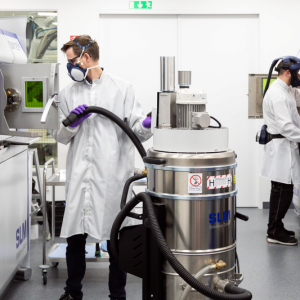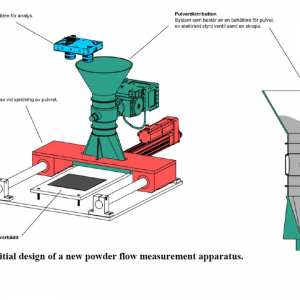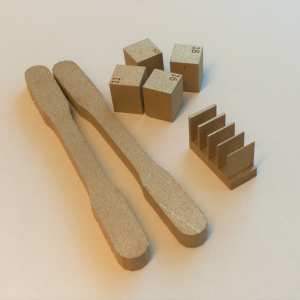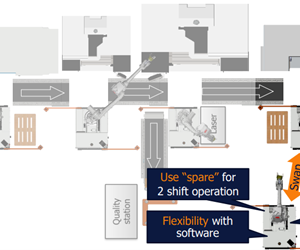
Project time: 2021 – 2024
Budget: 9 850 000 kronor
Assessing the Robustness of the Laser Powder Bed Fusion Process
There is a delicate interplay between process flexibility and process robustness. As the flexibility of a manufacturing process increases, the identification and control of the sources of variation become more challenging. This project investigates the robustness of the Laser Powder Bed Fusion (LPBF) process with a focus on the integrity of thin walls and narrow channels produced with this technology. For parts where the performance is heavily reliant on thin walls (e.g., for heat transfer) and narrow channels (e.g., for fluid transfer) a robust LPBF production that can guarantee fluid tightness, high mechanical strength and dimensional accuracy is critical. Today, the uncertainty about LPBF process robustness is a major obstacle for industrialization of this technology for serial production.
A full-scale robustness study is costly and requires extensive empirical testing. The objective of this project is to develop a new methodology for evaluation of process robustness which is cost-effective and less test intensive. This new methodology is based on predictions from LPBF process simulation and correlations with the layer-by-layer data generated with the process monitoring tools.
The project consortium constructs the complete production chain. The team includes two end-users (Alfa Laval and Siemens), and three key technology providers in the field of process simulation (MSC Software), production systems (SLM Solutions) and post processing (RENA). A material provider (Höganäs) and two service providers with expertise in the field of quality assurance (Nikon), and product design and process simulation (Etteplan) will support the project. The industrial team will work closely with RISE IVF and Chalmers University of Technology.
2016 – 2018
Reduced lead times and improved performance for tooling through innovative manufacturing and assembly strategies as well as optimised design enabled by use of additive manufacturing (AM).
2016 – 2018
The project's main goal is to develop a design and manufacturing methodology, for resource efficient additive manufacturing of components in the automotive industry.
2017 – 2020
The goal is to demonstrate the additive manufacturing of micrometer/millimeter wave components.
2019 – 2022
DIDAM develops and demonstrates digitalization solutions to industrialize Additive Manufacturing
2020 – 2023

This project intends to design and develop a new test methodology for evaluation of power flowability in powder bed fusion (PBF) systems. The test apparatus will simulate powder flow in PBF machines and can be used for optimizing the powder layering behavior for potential utilization of alternative powder qualities. Additionally, this equipment creates opportunities for both powder producers and AM part manufacturers to minimize powder waste and maximize material utilization.
2017 – 2018

IDAG aim to identify gaps and propose actions for the digital infrastructure necessary to industrialize additive manufacturing technologies. Actors from a new type of value chain of manufacturing companies – from powder to product – collaborate with digital solution providers and researchers to understand the needs and articulate the necessary actions through analysis of industrial cases. The target is to deliver a description in the form of a roadmap for how these actions can be developed and provided in order to ensure flexible and scalable digital platforms for additive manufacturing value chains.
2019 – 2019
The project aims to test the idea of an effective circulation system for material waste from additive manufacturing. Our goal is to map the prerequisites for closer collaboration between material suppliers and additive manufacturers, including new business models, partnerships and logistics solutions.
2017 – 2018
The aim of the project is to demonstrate utilization of additive manufacturing for copper-based products and process solutions and faster adaption
2016 – 2018

Design process from concept to printable stl-file for AM including surface based networks in the structure.
2019 – 2022
2014 – 2016
This project aims to contribute to the development of future ERP-systems. The project will explore how to offer work, redefine work roles and challenge companies to make use of advanced systems support and the technology within and around these. Overall, the project aims to contribute to the development of both the next generation of ERP-systems and a complementary change in the way firms see upon work organization, so that technology can support and meet the needs of the humans within organisations rather than enforcing structures upon them.
2019 – 2019
The main idea of the project is to investigate and demonstrate how the digitalized and proven systems and technologies of the Process Industry, like CPAS, can be used in DM to improve competitiveness and drive growth
2017 – 2019
2014 – 2017
The overall goal of DiSAM is to create a unique test AM Hub in Sweden for metal and polymer based additive manufacturing processes.
2017 – 2021
The project aims to develop a new cyber-physical framework to realize extremely flexible production.
2021 – 2024

Robotic solutions with autonomous decision-making software supporting on-demand production using resource pools.
2021 – 2024
DiLAM strengthens the competitiveness of the Swedish manufacturing industry by aligning the digital and physical supply chains for additive manufacturing of large parts.
2017 – 2020
2013 – 2016
